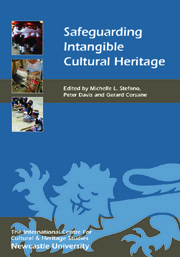Book contents
- Frontmatter
- Contents
- List of Illustrations
- Acknowledgments
- Touching the Intangible: An Introduction
- NEGOTIATING AND VALUING THE INTANGIBLE
- APPLYING THE INTANGIBLE CULTURAL HERITAGE CONCEPT
- 8 Reflections on the Implementation of the UNESCO 2003 Convention for the Safeguarding of Intangible Cultural Heritage in France
- 9 Government and Intangible Heritage in Australia
- 10 Proud to be Dutch? Intangible Heritage and National Identity in the Netherlands
- 11 Intangible Cultural Heritage in Wales
- 12 Conversation Piece: Intangible Cultural Heritage in Botswana
- 13 The UNESCO Convention for the Safeguarding of Intangible Cultural Heritage and its Implications for Sustaining Culture in Nova Scotia
- ON THE GROUND: SAFEGUARDING THE INTANGIBLE
- List of Contributors
- Index
11 - Intangible Cultural Heritage in Wales
from APPLYING THE INTANGIBLE CULTURAL HERITAGE CONCEPT
Published online by Cambridge University Press: 05 February 2013
- Frontmatter
- Contents
- List of Illustrations
- Acknowledgments
- Touching the Intangible: An Introduction
- NEGOTIATING AND VALUING THE INTANGIBLE
- APPLYING THE INTANGIBLE CULTURAL HERITAGE CONCEPT
- 8 Reflections on the Implementation of the UNESCO 2003 Convention for the Safeguarding of Intangible Cultural Heritage in France
- 9 Government and Intangible Heritage in Australia
- 10 Proud to be Dutch? Intangible Heritage and National Identity in the Netherlands
- 11 Intangible Cultural Heritage in Wales
- 12 Conversation Piece: Intangible Cultural Heritage in Botswana
- 13 The UNESCO Convention for the Safeguarding of Intangible Cultural Heritage and its Implications for Sustaining Culture in Nova Scotia
- ON THE GROUND: SAFEGUARDING THE INTANGIBLE
- List of Contributors
- Index
Summary
INTRODUCTION
If the legendary visitor from Outer Space (or even a researcher from much nearer) tried to find an official definition of ICH in Wales, he or she would be sorely tested. The small amount of information regarding ICH that is available reminds one of the early encyclopaedia entry: ‘WALES, See ENGLAND’ (Encyclopaedia Britannica 1898, vol XXIV, 325). The influence of the ‘authorised heritage discourse’ (AHD) within the UK and the political implications of implementing the 2003 Convention keep the mainstream heritage sector very much based on the tangible (see Smith 2006). The dichotomy of tangible and intangible heritage described by Ardouin (2007, 125) has not been resolved; Hassard's (2009, 285) plea that the UK ‘must surely now embrace the idea of the intangible by ratifying the 2003 Convention’ has not been acted upon. Moreover, the difficulty in extricating English views from wider UK perspectives, particularly in the political sphere, is evidenced in Smith and Waterton (2009). In their discussion on ICH in England, ‘England’ or ‘English’ are used 15 times and ‘UK’ or ‘British’ 16, with no obvious reason for the change of wording (see Smith and Waterton 2009). This difficulty in differentiating between the UK as a concept and attributing any particular view to it as a whole, including what may be very different views held in its constituent parts, is shown in the differing responses to the 2003 Convention, as discussed later.
- Type
- Chapter
- Information
- Safeguarding Intangible Cultural Heritage , pp. 137 - 148Publisher: Boydell & BrewerPrint publication year: 2012



